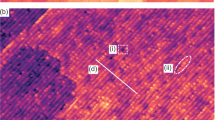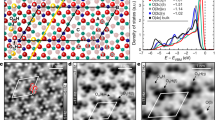Abstract
The reactivity of water at Ag(111), Zn(0001) and Cu(111) surfaces studied by X-ray photoelectron and high resolution electron spectroscopies at low temperatures (80–295 K) is reviewed. Emphasis is given to the coadsorption approach in revealing mechanisms for oxygen–water reactions with comparisons made with previous studies and the models proposed for ammonia–oxygen reactions at metal surfaces. Transient dioxygen–water precursor states result in facile and extensive surface hydroxylation with implications for catalytic oxidation. The orientation of the hydroxyl states with respect to the surface normal are sensitive to the oxygen–water ratio and for high oxygen ratios (200:1) an unreactive oxide overlayer forms at Cu(111) and Zn(0001). The significance of weakly adsorbed complexes, dioxygen–water and carbon dioxide–water, is discussed and, provided they are not kinetically controlled, are models for reactions at high pressures and temperatures with insights to the mechanisms of “real” catalytic reactions. Although scanning tunnelling microscopy has revealed “complex and unpredictable” water structures at low temperatures at metal surfaces, their reactivity and surface dynamics have received less attention.
Graphical Abstract








Similar content being viewed by others
References
Thiel PA, Madey TE (1987) The Interaction of Water with Solid Surfaces: fundamental Aspects. Surf Sci Reports 7(6–8):211–385
Au CT, Roberts MW (1980) Photoelectron spectroscopic evidence for the activation of adsorbate bonds by chemisorbed oxygen. Chem Phys Lett 74(3):472–474
Au CT, Roberts MW (1981) An XPS study of the influence of chemisorbed oxygen on the adsorption of ethylene and water vapour by Cu(110) and Cu(111) Surfaces. J de Chimie Physique 78(11, 12):921–926
Au CT, Roberts MW (1986) Specific role of transient O− (s) at Mg (0001) surfaces in activation of ammonia by oxygen and nitrous oxide. Nature 319(6050):206–208
Au CT, Roberts MW (1987) The promotion of surface-catalysed reactions by gaseous additives: the role of a surface oxygen transient. J Chem Soc Faraday Trans 183:2047–2049 (Discussion Faraday Symposium 21, p 2085)
Afsin B, Davies PR, Pashuski A, Roberts MW (1991) The role of a dioxygen precursor in the selective formation of imide NH (a) species at a Cu (110) surface. Surf Sci Lett 259:L724–L728
Boronin A, Pashuki A, Roberts MW (1992) A new approach to the mechanism of heteregenously catalysed reactions: the oxydehydrogenation of ammonia at a Cu(111) surface. Cat Lett 16:345–350
Roberts MW (1991) Evidence for the role of surface transients and precursor states in determining molecular pathways in surface reactions. Appl Surf Sci 52:133–140
Roberts MW (1994) Chemisorption and reactions at metal surfaces. Surf Sci 299(300):769–784
Carley AF, Davies PR, Roberts MW, Thomas KK, Yan S (1998) Oxygen states present at a Ag(111) surface in the presence of ammonia: evidence for a NH3···O δ−2 complex. Chem Commun 35–36
Marcus RA (2010) Spiers memorial lecture: interplay of theory and computation in chemistry—examples from on-water organic catalysis, enzyme catalysis and single molecule fluctuations. Faraday Disc 145:9–14
Moore FG, Richmond GL (2008) Integration or segregation: how do molecules behave at oil–water interfaces? Acc Chemical Res 41(6):739–748
Roberts MW (2011) Hetergeneously catalysed oxidation reactions with P450—like characteristics: radical reactions and the ‘elusive’ oxygen state. Cat Lett 141:365
Carley AF, Roberts MW, Yan S (1988) Intramolecular charge-transfer and the cleavage of the dioxygen bond at metal surfaces: oxygen at Zn (0001). Cat Lett 1:265–270
Carley AF, Davies PR, Roberts MW, Shukla N, Song Y, Thomas KK (1994) The hydroxylation of Cu (111) and Zn (0001) surfaces. Appl Surf Sci 81:265–272
Davies PR, Roberts MW (2008) Atom resolved surface reactions: nanocatalysis. The Royal Society of Chemistry
Afsin B, Davies PR, Pashuski A, Roberts MW, Vincent D (1993) Reaction pathways in the oxydehyrogenation of ammonia at Cu (110) surfaces. Surf Sci 284:109–120
Freund H-J, Roberts MW (1996) Surface chemistry of carbon dioxide. Surf Sci Rep 25(8):225–273
Carley AF, Gallagher D, Roberts MW (1987) Activation of carbon dioxide at low temperatures at aluminium surfaces. Surf Sci 183:L263–L268
Carley AF, Hawkins G, Read S, Roberts MW (1999) Reactions of co-adsorbed carbon dioxide and dioxygen at Mg(0001) at low temperatures. Top Catal 8:243–248
Carley AF, Davies PR, Moser EM, Roberts MW (1996) Facile hydrogenation of carbon dioxide at Al (111) surfaces: the role of coadsorbed water. Surf Sci 364:L563–L567
Deng X, Verdaguer A, Herranz T, Weis C, Blum H, Salmeron M (2008) Surface chemistry of Cu in the presence of CO2 and H2O. Langmuir 24:9474–9478
Davies PR, Roberts MW (1992) Activation of carbon-dioxide by ammonia at Cu(100) and Zn(0001) surfaces leading to the formation of a surface carbamate. J Chem Soc, Faraday Trans 88:361–368
Roberts MW (1989) The nature and reactivity of chemisorbed oxygen and oxide overlayers at metal surfaces as revealed by photoelectron spectroscopy, in Structure and Reactivity of Surfaces In: Morterra C, Zechima A, Costa G (eds). Elsevier, Amsterdam
AuCT Roberts MW, Zhu AR (1982) Surface hydroxylation at a Zn (0001)-O surface. Surf Sci 115:L117–L123
Ito T, Lunsford JH (1985) Synthesis of ethylene and ethane by partial oxidation of methane over lithium-doped magnesium oxide. Nature 314(6013):721–722
Au CT, Li XC, Tang JA, Roberts MW (1987) The role of surface oxygen in reactions of propylene at Mg(0001) surfaces. J Catal 106:538–543
Roberts MW (2006) The role of short-lived oxygen transients and precursor states in the mechanism of surface reactions: a different view of surface catalysis. Chem Soc Rev 437
Ertl G (2000) Heteregeneous catalysis on the atomic scale the Japan chemical Journal Forum and John Wiley and Sons Inc. p 33
Carley AF, Davies PR, Roberts MW (2011) Oxygen transient states in catalytic oxidation at metal surfaces. Catalysis Today 169:118–124
Neurock M, vanSanten RA, Biemolt W, Jansen APJ (1994) Atomic and molecular oxygen as chemical precursors in the oxidation of ammonia by Copper. J Amerchem Soc 116:6860–6872
Carrasco J, Hodgson A, Michaelides A (2012) A Molecular perspective of water at metal interfaces. Nat Mater 11:667–674
Joyner RW, Roberts MW (1979) A study of the adsorption of oxygen on silver at high pressure by electron spectroscopy. Chem Phys Lett 60(3):459–462
Kendelewicz T, Kaya S, Newberg JT, Bluhm H, Mulakaluri N, Moritz W, Scheffler M, Nilsson A, Pentcheva R, Brown GE (2013) X-ray photoemission and density functional theory study of the interaction of water vapour with the Fe3O4 (0001) surface at near ambient conditions. J Phys Chem C 117:2719–2733
Starr DE, Liu Z, Hävecker M, Knop-Gericke A, Bluhm H (2012) Investigation of solid–vapour interfaces using ambient pressure XPS. Chem Soc Rev 42:5833–5857
Roberts MW (1981) Molecular events at solid surfaces plenary lecture 4th International Conference on Surface and Colloidal Science Israel. Pure Appl Chem 53:2269–2281
Acknowledgments
The support of EPSRC, the Royal Society and the European Communities (Brite Euram programme), the contributions of co-workers mentioned in the publications, and in particular Philip Davies and Albert Carley, are gratefully acknowledged.
Author information
Authors and Affiliations
Corresponding author
Rights and permissions
About this article
Cite this article
Roberts, M.W. Low Energy Pathways and Precursor States in the Catalytic Oxidation of Water and Carbon Dioxide at Metal Surfaces and Comparisons with Ammonia Oxidation. Catal Lett 144, 767–776 (2014). https://doi.org/10.1007/s10562-014-1225-5
Received:
Accepted:
Published:
Issue Date:
DOI: https://doi.org/10.1007/s10562-014-1225-5




